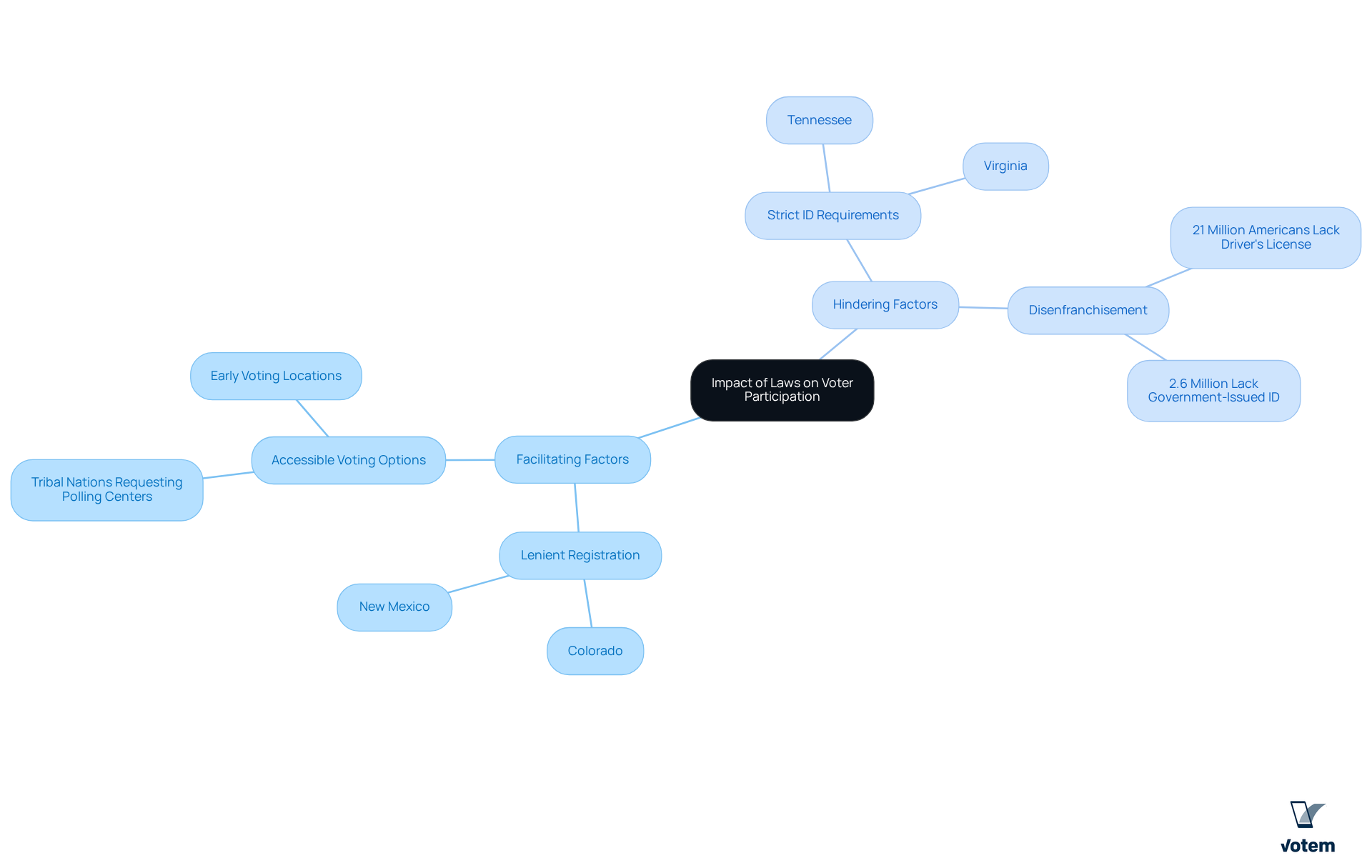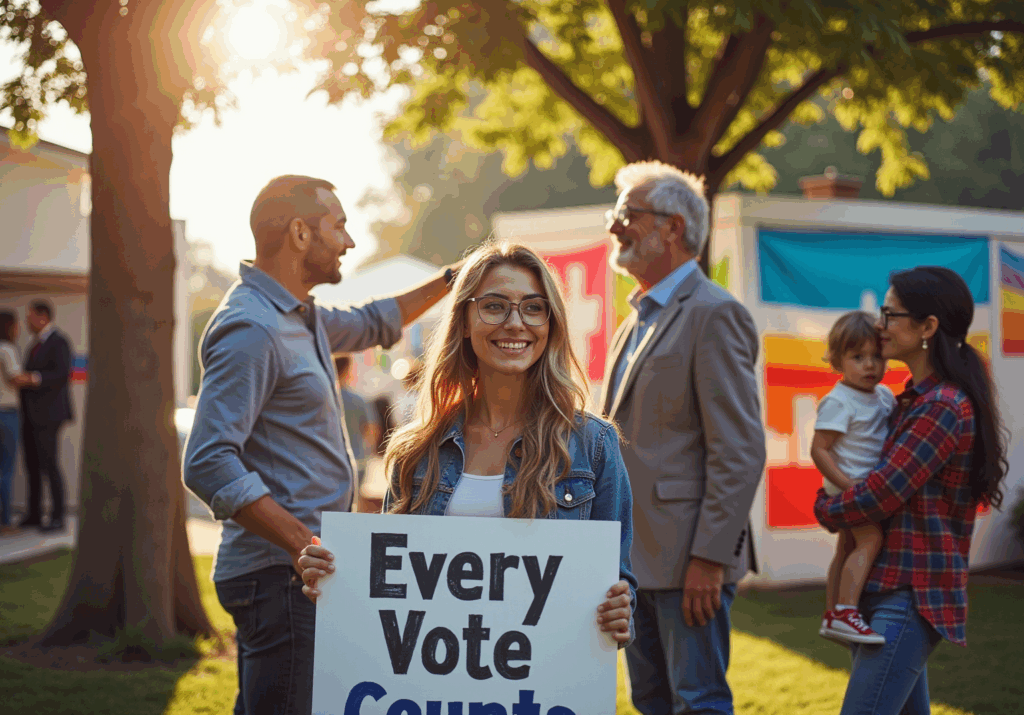Overview
Key factors adversely affecting voter turnout in the U.S. include:
- Socioeconomic barriers
- Stringent identification laws
- Misinformation about voting procedures
- Accessibility issues
- Election timing
These elements create significant obstacles for potential voters, particularly within marginalized communities. Such barriers not only undermine electoral participation but also threaten the integrity of the democratic process. Addressing these issues is crucial for fostering a more inclusive electoral environment. Therefore, it is imperative that union leadership recognizes these challenges and advocates for solutions that enhance voter engagement and accessibility.
Introduction
Voter turnout serves as a vital barometer of democracy, reflecting civic engagement and the public’s commitment to shaping governance. However, a multitude of factors, ranging from socioeconomic barriers to stringent voter ID laws, significantly hampers participation in the electoral process across the United States. As the nation grapples with these challenges, the pressing question emerges: how can understanding and addressing these obstacles lead to a more inclusive and representative democracy? Furthermore, addressing these issues is not merely an academic exercise; it is essential for fostering a political landscape where every voice is heard and valued.
Define Voter Turnout and Its Importance
Participation in an election is defined as the percentage of qualified individuals who engage by casting their ballots. This metric serves as a crucial indicator of civic engagement and the overall health of democracy, reflecting the public’s commitment to the political process. High participation in elections is associated with a more representative government, as it indicates that a varied segment of the population is engaged in influencing policies and decisions. Conversely, low turnout raises concerns about which of the following factors are said to adversely affect voter turnout in the United States, as well as the legitimacy of election results and the effectiveness of governance.
For instance, during the 2020 U.S. Presidential Election, approximately 66% of eligible individuals took part, demonstrating a notable degree of involvement relative to historical patterns. Organizations like Votem play a pivotal role in enhancing electoral participation by providing secure online voting solutions that simplify the voting process and increase accessibility. As emphasized by Linda McCulloch, implementing Votem’s modern system permitted increased access for all eligible participants, including military personnel and individuals with disabilities.
Furthermore, Votem successfully handled the receipt of 299,000 votes on behalf of the National Radio Hall of Fame, marking a 30% increase from the previous year. By utilizing technology, Votem aids in creating an atmosphere where participation in elections is prioritized, ultimately enhancing a healthier democratic landscape. As Rev. Theodore Hesburgh stated, ‘Voting is a civic sacrament,’ underscoring the importance of participation in the electoral process.

Identify Key Factors Adversely Affecting Voter Turnout
Several key factors adversely affect voter turnout in the U.S.:
-
Socioeconomic Status: Individuals from lower-income backgrounds often encounter significant barriers to voting, including lack of transportation, time constraints, and limited access to information about the voting process. Research indicates that those without a high school degree are four times more likely to lack a driver’s license with their current name and address, further complicating their ability to participate in elections. This underscores the urgent need for initiatives that address these disparities.
-
Stringent identification criteria in Elector ID Laws raise the question of which of the following factors are said to adversely affect voter turnout in the United States, as they can exclude eligible participants, particularly among minority and low-income groups who may lack the necessary documentation. The fact that approximately 34.5 million Americans do not possess any form of government-issued ID raises concerns about which of the following factors are said to adversely affect voter turnout in the United States under strict identification laws. Although research indicates that these regulations have minimal influence on overall electoral participation, they disproportionately impact marginalized communities, worsening existing disparities. Thus, reforming these laws is essential for enhancing electoral inclusivity.
-
The spread of false information regarding voting procedures contributes to confusion and discouragement among potential voters, which of the following factors are said to adversely affect voter turnout in the United States? Many individuals are unaware of their state’s ID requirements, leading to misconceptions that obstruct involvement. Addressing this misinformation is crucial for empowering voters and ensuring they have the correct information to participate effectively.
-
Accessibility issues, such as physical barriers including the location of polling places and inadequate accommodations for individuals with disabilities, raise the question of which of the following factors are said to adversely affect voter turnout in the United States? Ensuring that polling locations are accessible and well-publicized is crucial for increasing participation in elections. As noted by Linda McCulloch, “Implementing Votem’s new, modern system which allowed greater access for all qualified voters from military voters to voters with disabilities was my greatest accomplishment in office.” This highlights the importance of accessibility in fostering a more inclusive electoral environment.
-
One of the election timing factors to consider is which of the following factors are said to adversely affect voter turnout in the United States, such as elections held on weekdays or during work hours, which can limit the ability of working individuals to vote. Policies that permit same-day registration and early balloting have been demonstrated to boost participation, especially among underrepresented populations. These measures are vital for accommodating diverse work schedules and ensuring that all voices are heard in the electoral process.
Tackling these elements is vital for organizations such as Votem, which aim to establish inclusive and accessible electoral environments. By comprehending and addressing these obstacles, electoral participation can be significantly enhanced, promoting a more representative democracy.

Examine the Impact of Laws on Voter Participation
Laws significantly shape electoral engagement in the U.S., particularly when considering which of the following factors are said to adversely affect voter turnout in the United States, with regulations such as identification requirements, registration mandates, and early ballot provisions playing crucial roles in either facilitating or hindering access to the polls. States that implement lenient registration processes and provide accessible voting options—like Colorado and New Mexico—frequently report higher participation rates. For example, Colorado’s legislation allowing Tribal Nations to request polling centers within their reservations has markedly improved accessibility for Native American individuals, resulting in increased participation.
Conversely, states that enforce stringent ID regulations, such as Tennessee and Virginia, often experience a decline in electoral participation, highlighting which of the following factors are said to adversely affect voter turnout in the United States. The issue of disenfranchisement under strict ID laws raises the question of which of the following factors are said to adversely affect voter turnout in the United States, considering that nearly 21 million Americans lack a driver’s license and 2.6 million do not possess any form of government-issued photo identification. Research indicates that alerts about ID requirements can positively influence turnout; for instance, a ‘warning’ note in Tennessee led to a 1.5 percentage point increase in engagement.
Moreover, regulations that protect against intimidation and discrimination are essential for ensuring that all eligible individuals can exercise their rights without fear. The ongoing debates surrounding voting rights legislation highlight the critical need for a legal environment that fosters participation, especially for marginalized communities. As voter ID laws continue to evolve, it is vital to understand which of the following factors are said to adversely affect voter turnout in the United States to promote an inclusive electoral process.

Conclusion
Understanding the factors that adversely affect voter turnout in the U.S. is crucial for fostering a more inclusive and representative democracy. This article highlights significant barriers that hinder participation, including:
- Socioeconomic disparities
- Stringent voter ID laws
- Misinformation
- Accessibility challenges
Each of these elements plays a vital role in shaping the electoral landscape, emphasizing the urgent need for reforms that prioritize voter engagement and accessibility.
Key insights reveal that:
- Socioeconomic status directly impacts an individual’s ability to vote
- Strict identification requirements disproportionately affect marginalized communities
- Misinformation surrounding voting procedures creates confusion
- Physical barriers at polling places limit access for individuals with disabilities
- The timing of elections can restrict participation, especially for those with demanding work schedules
Addressing these issues is essential for organizations and policymakers aiming to enhance voter turnout and ensure that every voice is heard in the democratic process.
Ultimately, the significance of voter participation cannot be overstated. It is the foundation of a healthy democracy, reflecting the public’s engagement and commitment to the political process. As the U.S. moves forward, it is imperative to advocate for policies that dismantle barriers to voting, promote accessibility, and ensure that all citizens can exercise their rights without obstacles. By prioritizing these efforts, a more vibrant and representative democracy can emerge, where every eligible voter has the opportunity to contribute to shaping the future.
Frequently Asked Questions
What is voter turnout?
Voter turnout is defined as the percentage of qualified individuals who participate in an election by casting their ballots.
Why is voter turnout important?
Voter turnout is important because it serves as a crucial indicator of civic engagement and the overall health of democracy. High participation reflects the public’s commitment to the political process and leads to a more representative government.
What are the consequences of low voter turnout?
Low voter turnout raises concerns about the legitimacy of election results and the effectiveness of governance, as it may indicate that only a limited segment of the population is influencing policies and decisions.
How did voter turnout in the 2020 U.S. Presidential Election compare to historical patterns?
Approximately 66% of eligible individuals participated in the 2020 U.S. Presidential Election, demonstrating a notable degree of involvement relative to historical patterns.
What role does Votem play in enhancing electoral participation?
Votem enhances electoral participation by providing secure online voting solutions that simplify the voting process and increase accessibility for all eligible participants, including military personnel and individuals with disabilities.
Can you provide an example of Votem’s impact on voter turnout?
Votem successfully handled the receipt of 299,000 votes on behalf of the National Radio Hall of Fame, marking a 30% increase in participation from the previous year.
What is the significance of the quote by Rev. Theodore Hesburgh regarding voting?
Rev. Theodore Hesburgh stated, ‘Voting is a civic sacrament,’ which underscores the importance of participation in the electoral process and highlights the value of voting in a democratic society.
List of Sources
- Define Voter Turnout and Its Importance
- 10 Voter Turnout Examples That Boost Engagement and Trust | Online Voting with Votem® (https://votem.com/10-voter-turnout-examples-that-boost-engagement-and-trust)
- What Is Voter Turnout and Why It Matters for Unions | Online Voting with Votem® (https://votem.com/what-is-voter-turnout-and-why-it-matters-for-unions)
- Identify Key Factors Adversely Affecting Voter Turnout
- New CDCE Survey Shows Millions Lack ID as Voter ID Laws Spread to More States | CDCE l Center for Democracy and Civic Engagement (https://cdce.umd.edu/feature/new-cdce-survey-shows-millions-lack-id-voter-id-laws-spread-more-states)
- 15.5C: Voting Behavior (https://socialsci.libretexts.org/Bookshelves/Sociology/Introduction_to_Sociology/Sociology_(Boundless)/15:_Government/15.05:_The_U.S._Political_System/15.5C:_Voting_Behavior)
- Voter demographics, access, and turnout – SciLine (https://sciline.org/elections/2024-science-issues/voter-access-turnout)
- The Effects of Voter ID Notification on Voter Turnout in the United States | The Abdul Latif Jameel Poverty Action Lab (https://povertyactionlab.org/evaluation/effects-voter-id-notification-voter-turnout-united-states)
- Examine the Impact of Laws on Voter Participation
- New CDCE Survey Shows Millions Lack ID as Voter ID Laws Spread to More States | CDCE l Center for Democracy and Civic Engagement (https://cdce.umd.edu/feature/new-cdce-survey-shows-millions-lack-id-voter-id-laws-spread-more-states)
- The Effects of Voter ID Notification on Voter Turnout in the United States | The Abdul Latif Jameel Poverty Action Lab (https://povertyactionlab.org/evaluation/effects-voter-id-notification-voter-turnout-united-states)
- Four States Open the Door to Automatic Voter Registration for Native Americans – Institute for Responsive Government (https://responsivegov.org/research/four-states-open-the-door-to-automatic-voter-registration-for-native-americans)
- Infographic: What Effect Will Voter ID Laws Have in the 2024 Election? (https://statista.com/chart/32805/voter-identification-laws-in-the-us-by-state?srsltid=AfmBOop_lE0SRUV1XM7Abh49LCBchD3usTzDBp20RaHIZOmPs9eMHC8G)

